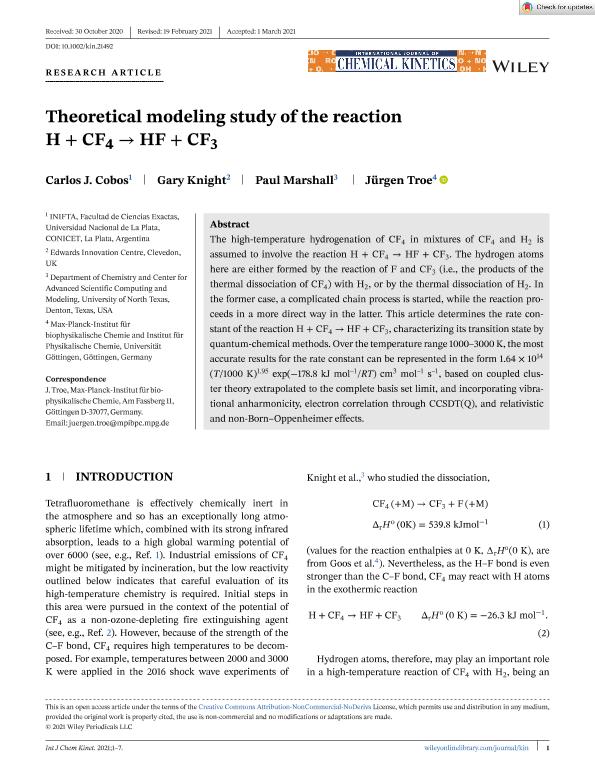Mostrar el registro sencillo del ítem
dc.contributor.author
Cobos, Carlos Jorge

dc.contributor.author
Knight, Gary
dc.contributor.author
Marshall, Paul
dc.contributor.author
Troe, Jürgen
dc.date.available
2022-10-06T13:17:50Z
dc.date.issued
2021-08
dc.identifier.citation
Cobos, Carlos Jorge; Knight, Gary; Marshall, Paul; Troe, Jürgen; Theoretical modeling study of the reaction H + CF4 → HF + CF3; John Wiley & Sons Inc.; International Journal of Chemical Kinetics; 53; 8; 8-2021; 939-945
dc.identifier.issn
0538-8066
dc.identifier.uri
http://hdl.handle.net/11336/172186
dc.description.abstract
The high-temperature hydrogenation of CF4 in mixtures of CF4 and H2 is assumed to involve the reaction H + CF4 → HF + CF3. The hydrogen atoms here are either formed by the reaction of F and CF3 (i.e., the products of the thermal dissociation of CF4) with H2, or by the thermal dissociation of H2. In the former case, a complicated chain process is started, while the reaction proceeds in a more direct way in the latter. This article determines the rate constant of the reaction H + CF4 → HF + CF3, characterizing its transition state by quantum-chemical methods. Over the temperature range 1000–3000 K, the most accurate results for the rate constant can be represented in the form 1.64 × 1014 (T/1000 K)1.95 exp(−178.8 kJ mol–1/RT) cm3 mol–1 s–1, based on coupled cluster theory extrapolated to the complete basis set limit, and incorporating vibrational anharmonicity, electron correlation through CCSDT(Q), and relativistic and non-Born–Oppenheimer effects.
dc.format
application/pdf
dc.language.iso
eng
dc.publisher
John Wiley & Sons Inc.

dc.rights
info:eu-repo/semantics/openAccess
dc.rights.uri
https://creativecommons.org/licenses/by-nc-nd/2.5/ar/
dc.subject
Theoretical modeling
dc.subject
Reaction H + CF4 → HF + CF3
dc.subject.classification
Físico-Química, Ciencia de los Polímeros, Electroquímica

dc.subject.classification
Ciencias Químicas

dc.subject.classification
CIENCIAS NATURALES Y EXACTAS

dc.title
Theoretical modeling study of the reaction H + CF4 → HF + CF3
dc.type
info:eu-repo/semantics/article
dc.type
info:ar-repo/semantics/artículo
dc.type
info:eu-repo/semantics/publishedVersion
dc.date.updated
2022-09-20T10:49:14Z
dc.journal.volume
53
dc.journal.number
8
dc.journal.pagination
939-945
dc.journal.pais
Estados Unidos

dc.description.fil
Fil: Cobos, Carlos Jorge. Consejo Nacional de Investigaciones Científicas y Técnicas. Centro Científico Tecnológico Conicet - La Plata. Instituto de Investigaciones Fisicoquímicas Teóricas y Aplicadas. Universidad Nacional de La Plata. Facultad de Ciencias Exactas. Instituto de Investigaciones Fisicoquímicas Teóricas y Aplicadas; Argentina
dc.description.fil
Fil: Knight, Gary. Edwards Innovation Centre; Reino Unido
dc.description.fil
Fil: Marshall, Paul. University of North Texas; Estados Unidos
dc.description.fil
Fil: Troe, Jürgen. Universität Göttingen; Alemania
dc.journal.title
International Journal of Chemical Kinetics

dc.relation.alternativeid
info:eu-repo/semantics/altIdentifier/doi/http://dx.doi.org/10.1002/kin.21492
dc.relation.alternativeid
info:eu-repo/semantics/altIdentifier/url/https://onlinelibrary.wiley.com/doi/10.1002/kin.21492
Archivos asociados
